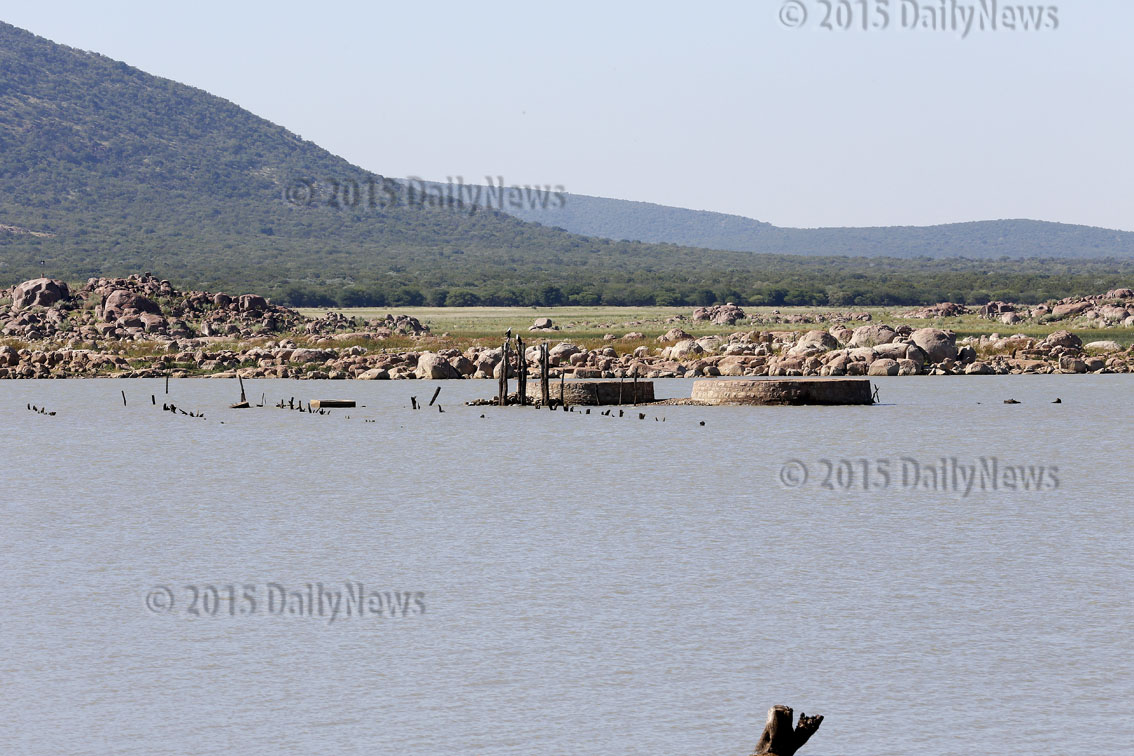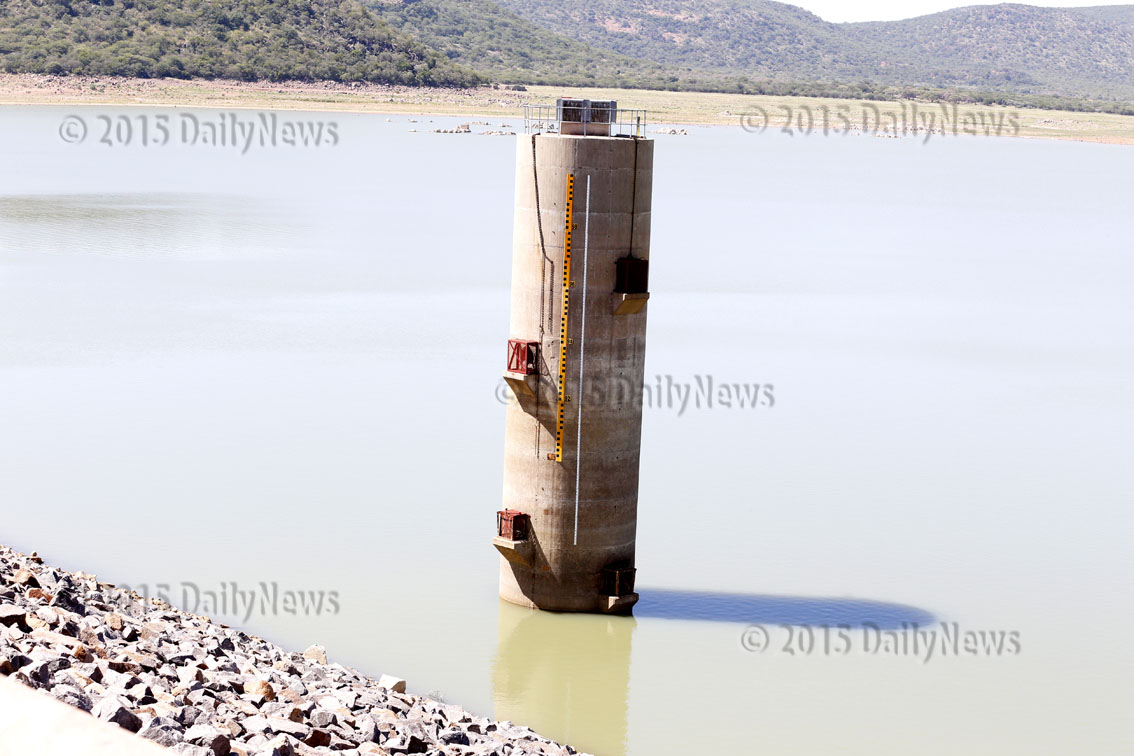Aftermaths of dry Gaborone Dam
31 Mar 2015
Species around the 10 kilometer dam in length once called the country’s biggest dam are dwindling as the dam itself is drying.
Its reputation of being a major water land mark has diminished and there are doubts to whether water lovers would ever have the guts to call it water front as they use to nick name it. It used to be called the largest man –made body of water in Botswana and now it seems to be a forgotten earth core structure which is the Gaborone dam.
The eastern vegetation on the façade of the mountainous area of the once ideal and admired sport for relaxation looks wilted. Gaborone dam has been the talk of radio mall and it will need plenty of rain to fill its capacity which is 141, 100, 000 cubic meters.
The Waterfront, an entertainment venue is located on the north bank and it is accurate to say that, it can no longer be termed a focus for much of the city’s water borne fun and activities.
The south bank water appears deeper with projecting rocks everywhere as the deep slopes towards the direction of Lobatse. The south bank was home for the Kalahari Fishing Club. The man -made lake was a home for water bird species like storks, ducks, waders, purple heron, great white egret, flamingos, giant kingfisher, marico sunbird and many more.
The slowly but surely drying of Gaborone dam has left tongues wagging and many question to be answered such as, what would be the future of the once magnificent water catchment in Botswana.
Giant rocks and withering water lilies can be spotted everywhere with debris visible in the water. During the visit the ‘old faithful, great beast’ as it has been described, the old Roman Catholic Church marked 1928 was visibly clear.
A citizen and security officer at Gaborone Yacht Club situated on the eastern side of the dam said they are seeing the church for the first time as it has been for more than forty years covered by water.
“Sometimes last year, 2014, an elderly woman was brought here by his daughter to see this church, I did not ask her name, but she said they used to worship her before the construction of the dam. We did not know these things, history has been revealed,” he said.
Gaborone Dam was last full in 2001 at exactly 100 percent with its water visible from buildings in commerce Park and since then the water has been declining. Currently Gaborone Dam is treading the last mile of its life with its level having gone down to 3 per cent.
It is obvious to conclude that business has been affected at Gaborone Yacht Club, the once an Island that could only be reached by canoes, now even a vehicle could cascade through the bumpy dusty road to the Gaborone Yacht Club.
It used to be popular for seminars, workshops, major sporting and social functions.
The Southern African Development Community has however said the current situation of Gaborone can best be provided by the institutions responsible citing the Department of Water Affairs.
Senior Programme officer, Water Sector for SADC Secretariat Mr Phera Ramoeli said it is their role to assist all SADC member states to improve water situations through a number of ways including encouraging cooperation in the management and use of shared water resources such as surface and groundwater in shared aquifers of which Botswana is a partaker.
Through the facilitation work that SADC Secretariat does as part of the implementation of the protocol on shared watercourses, the basin states have formed basin management organisations through which discussions are held and agreements reached on how support can be given to those who have needs, he said.
Mr Ramoeli noted that, there are discussions between Botswana and her co-riparian states in the Orange – Senqu, for Botswana to get water from the Lesotho Highlands to augment the water supply for Gaborone and other water stressed parts of southern Botswana.
He added that water resources of Southern Africa are vital for sustainable economic and social development of the region.
The resources are critical for meeting the basic needs related to water supply for domestic, industrial and agricultural requirements and for sanitation and waste management
The Department of Meteorology says the dam has been in decline for the past several years mainly due to insufficient rainfall over its catchment area. Principal Meteorologist Mr John Stegling says the dam’s catchment area is mainly to the south including Ramotswa, Lobatse, and Molapowabojang extending as far as Mmathethe.
These areas have seen a reduction in rain fall over the past few seasons and as such not enough water was able to reach the dam, Mr Stegling said.
Normally these areas should receive around 480-500mm of rain per annum, but rainfall has been below that for the past four years. Mr Stegling believes that high evaporation during summer also contribute to water loss at the dam.
On whether Batswana can expect strong rains to boost the dam sometimes during the course of the year, he said the country is in the last two months of summer and the rainy season will be ending soon in March. Thus far below normal rains have been experienced over the dam’s catchment area and inflow has been minimal, he said.
Mr Stegling alluded that rain fall for the area suggest below normal rainfall will be experienced for the remainder of the rainy season as such it is highly unlikely that the dam will fill.
It must be noted that high intensity is needed for the dam to start refilling up, he said, noting that this is scenario which although very unlikely, cannot totally be ruled out. He emphatically said the dam is unlikely to recover during the current season due to the below normal rains expected over its catchment area.
However, Director of Water Affairs Mr Obolokile Obakeng refutes that Gaborone dam is grappling with deficiency due to the fact that it is not near rivers that could support it.
He says the dam is located in such a way that it is supplied by flows from Notwane, Taung and Metsemaswaane Rivers. Mr Obakeng concurs with Mr Stegling that persistent low levels of rainfall over a period of time in the dam’s catchment area has resulted to the dry up.
Concerning allegations that 200 dams build in private properties in the catchment of the dam are hindering the flow of water into it, Mr Obakeng said, the estimated cumulative impact of small dams on the runoff to Gaborone dam has decline by 25% and decline in yield by 30 per cent.
The reduction of flows in relatively greater early in the hydrological year and the impact of small dams is exacerbated in dry years, he said. “It should be noted however that current state of depletion of the dam cannot only be attributed to the small dams upstream but also to cumulative decline of rain fall over long period.
Currently the water Affairs Department in collaboration with University of Botswana are carrying out a study which includes detailed analysis of the socioeconomic aspect of the small dams,” Mr Obakeng said.
The assessments of other possible reasons for drying of Gaborone dam take time and require detailed analysis, he said. But all in all, nothing can be left to fate, there are possibilities and indications that Gaborone dam will dazzle again.
With Dikgathong dam still to be connected to the North South water carrier and other government strategies to keep the dam sustainable, all is not lost for the mighty Gaborone dam. ENDS
Source : BOPA
Author : Idah Basimane
Location : GABORONE
Event : Dam feature
Date : 31 Mar 2015








